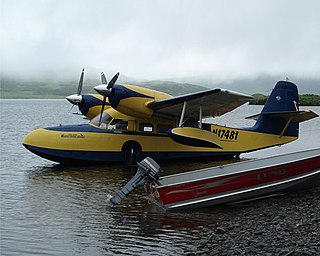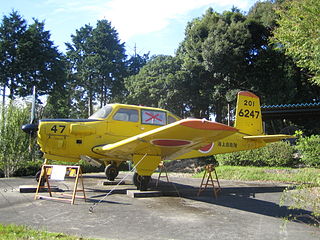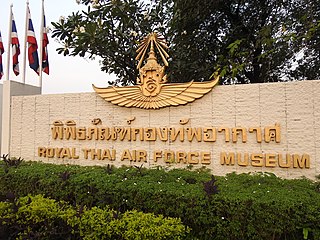
Don Mueang International Airport is one of two international airports serving the Bangkok Metropolitan Region, the other one being Suvarnabhumi Airport (BKK). Before Suvarnabhumi opened in 2006, Don Mueang was previously known as Bangkok International Airport.

The Fairey Firefly was a Second World War-era carrier-borne fighter aircraft and anti-submarine aircraft principally operated by the Fleet Air Arm (FAA). It was developed and built by the British aircraft manufacturer Fairey Aviation Company.

The North American Aviation T-28 Trojan is a radial-engined military trainer aircraft used by the United States Air Force and United States Navy beginning in the 1950s. Besides its use as a trainer, the T-28 was successfully employed as a counter-insurgency aircraft, primarily during the Vietnam War. It has continued in civilian use as an aerobatics and Warbird performer.

Surat Thani International Airport is an international airport located in Phunphin District, Surat Thani Province, in Southern Thailand. The airport, 21 km west of Surat Thani City, also is home to the Royal Thai Air Force (RTAF) squadrons. Surat Thani has a single paved runway. It is the tenth-busiest airport in Thailand in terms of passengers, handling more than two million passengers annually.

The Grumman G-44 Widgeon is a small, five-person, twin-engine amphibious aircraft. It was designated J4F by the United States Navy and Coast Guard and OA-14 by the United States Army Air Corps and United States Army Air Forces.

The Pacific Aerospace Corporation CT/4 Airtrainer series is an all-metal-construction, single-engine, two-place with side-by-side seating, fully aerobatic, piston-engined, basic training aircraft manufactured in Hamilton, New Zealand.

The Royal Thai Air Force or RTAF is the air force of the Kingdom of Thailand. Since its establishment in 1913 as one of the earliest air forces of Asia, the Royal Thai Air Force has engaged in numerous major and minor conflicts. During the Vietnam War era, the RTAF was supplied with USAF-aid equipment.

The Kaman HH-43 Huskie was a helicopter with intermeshing rotors used by the United States Air Force, the United States Navy and the United States Marine Corps from the 1950s until the 1970s. It was primarily used for aircraft firefighting and rescue in the close vicinity of air bases, but was later used as a short-range overland search and rescue aircraft during the Vietnam War.

Don Muang Royal Thai Air Force Base is approximately 40 kilometres north of central Bangkok and is the main operating and command base for the Royal Thai Air Force (RTAF). In addition, units of the Royal Thai Army and Royal Thai Police have personnel located there.

The RFB Fantrainer is a two-seat flight training aircraft which uses a mid-mounted ducted fan propulsion system. Developed and manufactured by German aircraft company Rhein-Flugzeugbau GmbH (RFB), it has been used by the Luftwaffe and Royal Thai Air Force.

The Percival Prince is a British light transport of the early postwar period. It was a twin-engine, high-wing, cantilever monoplane of all-metal stressed-skin construction; the undercarriage was of retractable, tricycle type.

The Fuji KM-2 is a Japanese propeller-driven light aircraft, which was developed by Fuji Heavy Industries from the Beech T-34 Mentor which Fuji built under licence. Various versions have been used as primary trainers by the Japan Self-Defense Forces, with the KM-2B remaining in service with the Japan Air Self-Defense Force.

The Royal Thai Air Force Museum is located in Don Mueang District, Bangkok, Thailand. It is located on the Phahonyothin Road just to the south of Wing 6 of the domestic terminal of the Don Mueang Airport. It was served by the Royal Thai Air Force Museum BTS station since 16 December 2020.

The Fuji LM-1 Nikko is a Japanese light communications aircraft of the 1950s.

The RTAF-5 was a Thai training and forward air control aircraft developed and built by the Science and Weapon Systems Development Centre of the Royal Thai Air Force in the 1980s. It was a twin-boom configuration aircraft powered by a single pusher turboprop engine, but only a single example was built.

The Baribatra or Bomber Type 2 was a two-seater light bomber aircraft of the 1920s designed and built by the Royal Siamese Air Force's Aeronautical Workshops. A small number were built for the Thai Air Force, with the type being the first Thai-designed aircraft.

The RTAF Security Force Command is a Division size unit in the Royal Thai Air Force. It has been in existence since 1937. They are based near Don Mueang International Airport. The RTAF Security Force Command is the main ground forces which providing Infantry for protecting air bases and high value assets, Special forces, Combat Controller (CCT), Combat Rescue Officer (CRO), Pararescue, Tactical Air Control Party, and anti-hijacking capabilities.

The RTAF-6 (บ.ทอ.๖) is a Thai training aircraft developed from the Italian SIAI-Marchetti SF.260MT trainer, and built by Thai Aviation Industry.

The RTAF-4Chanthra was a single-engine two-seat, single-engined primary trainer aircraft built by the Royal Thai Air Force's Science and Weapon Systems Development Centre.




















